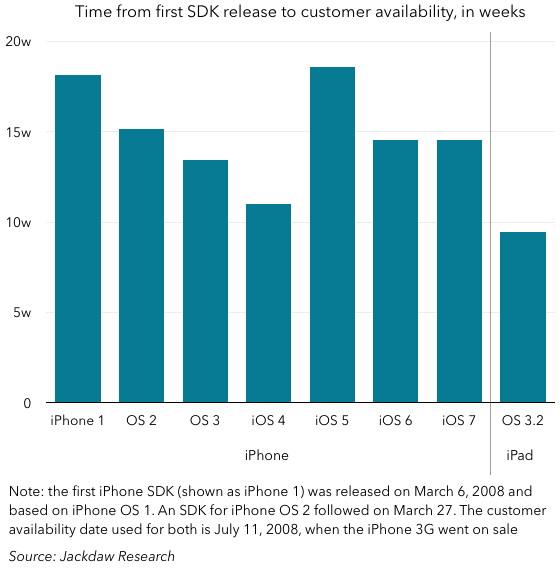Apple has established a pattern over the last six years with regard to releasing SDKs to developers ahead of releasing new software and hardware products to customers. The original iPhone didn’t follow this pattern, not having an App Store and therefore no SDK either. But since March 2008, Apple has given developers several months’ lead time to create apps which are optimized for its newest hardware and software releases. The times between SDK release and customer availability of the related products is shown in the chart below:
The exact length of time between SDK release and customer availability has bounced around a bit. When new iPhones were released in June, the SDKs arrived first in March, and then in April, slowly whittling down the time available for developers to create apps. Then, in 2011, Apple moved the whole schedule back a few months, with SDK release in the summer, and the new iPhone landing in the fall, and it stretched out the time in-between at the same time, moving it back to around 130 days. The last two releases have both seen exactly 102 days from SDK to customer availability. When Apple last introduced an entirely new hardware category, in 2010, it gave would-be iPad developers just over two months’ lead time.
As we approach the possible launch of new hardware in at least one category (wearables) and possibly two (smart home), it’s worth thinking about how this pattern might apply to these new categories. What’s most striking this time around is that I think it’s entirely possible that Apple has already done the SDK releases that will power these devices, and we therefore won’t see the long delay between the announcement of new hardware and its availability to the public. Apple has already laid the groundwork for new wearable devices as follows:
- In iOS 7, announced in June 2013 and available since September 2013, Apple tweaked the Notification Center and augmented Bluetooth capabilities to support better off-device notifications, for example on a smartwatch or similar device (Pebble and other third party smartwatches already make use of these)
- in iOS 8, announced at this year’s WWDC and presumably available in September 2014, Apple created HealthKit and the companion Health app, which can capture data from sensors in wearables and store and analyze them for users.
As such, depending on Apple’s implementation of wearables, it’s possible that it’s already given developers all the tools they need to create apps that will take advantage of whatever Apple releases. There may not be an “iWatch” SDK as such. If that’s the case, we could see the pattern shown in the chart above blown away completely with the release of wearable devices from Apple. Or, put another way, Apple has already started the clock ticking by releasing the SDKs to developers, and now we just need to wait for the other shoe to drop. And of course, if you believe the rumors about the smart home, the very same pattern would apply there – the necessary tools are all already out there in developers’ hands in the form of HomeKit.
If Apple is indeed planning an iWatch rather than something similar, it might need an SDK of its own for the on-device display, but if – as I suspect – what Apple ends up releasing looks a lot less like a watch and more like a much simpler device, then I think all the pieces may already be in place. On Monday, I’ll talk more about why I think what Apple releases might not be a watch at all, and why I think there will probably be several devices rather than just one.
